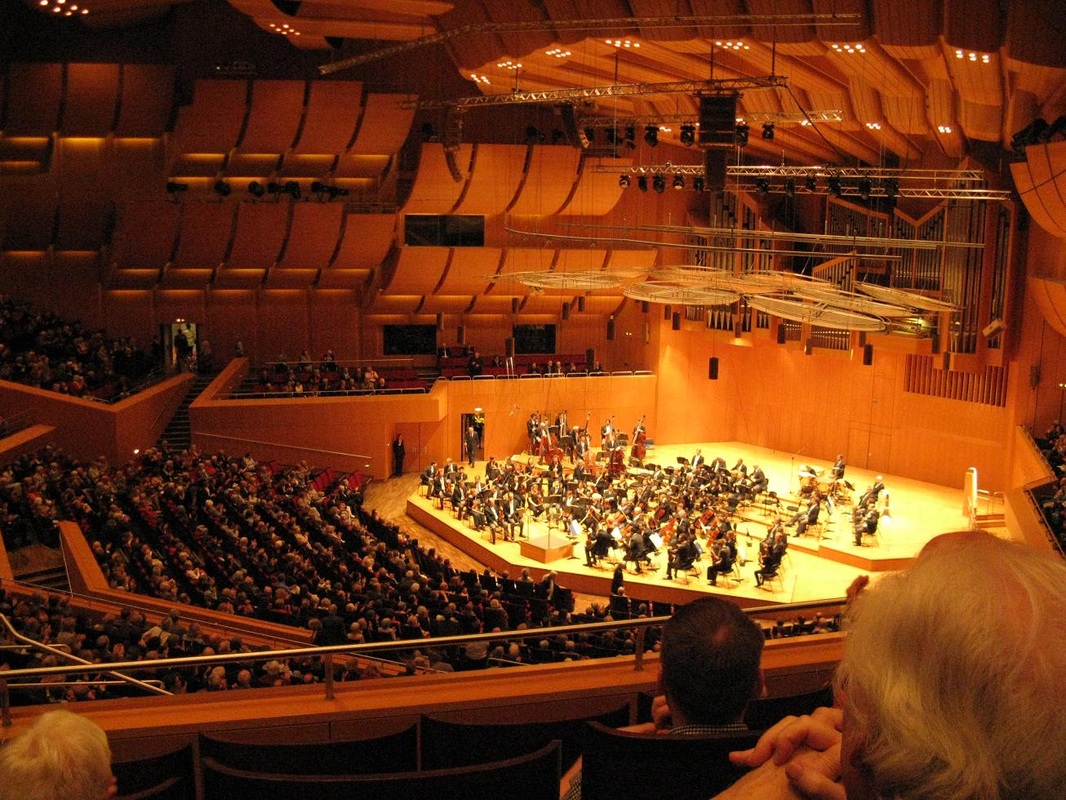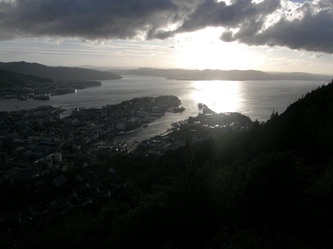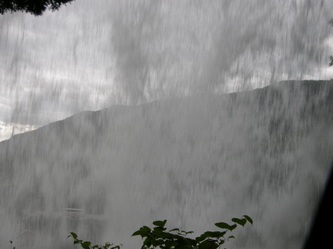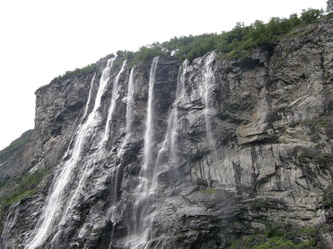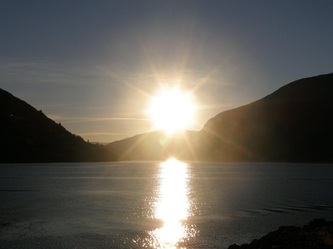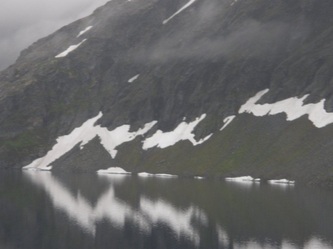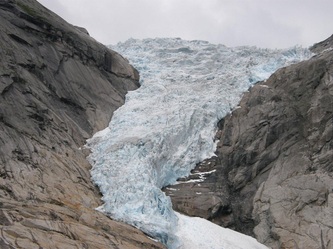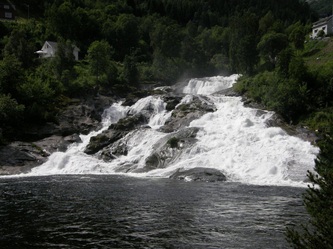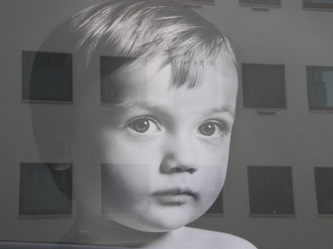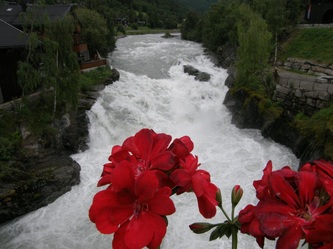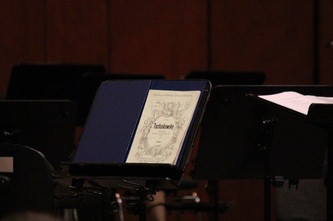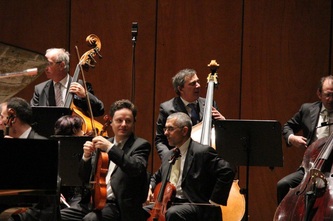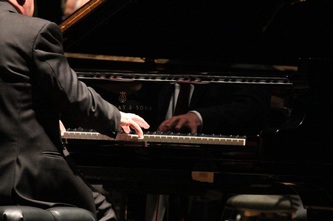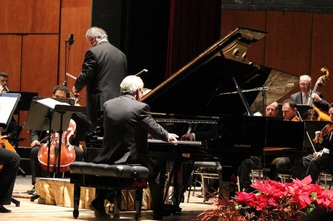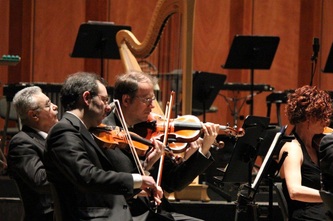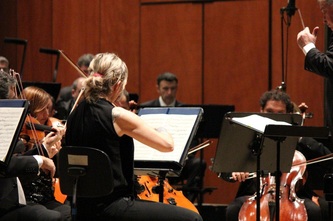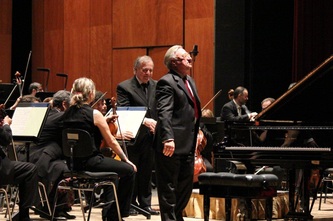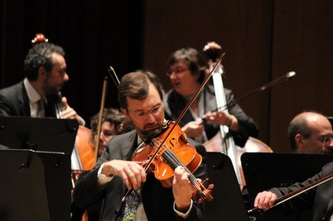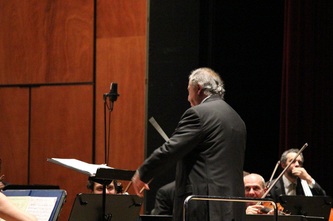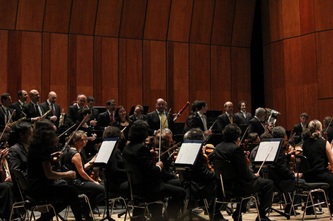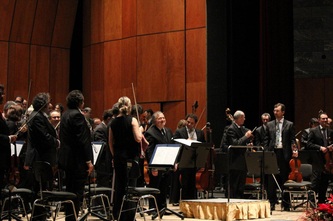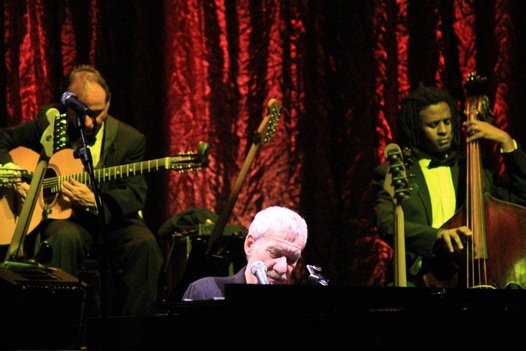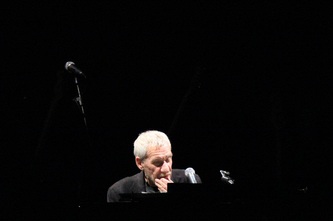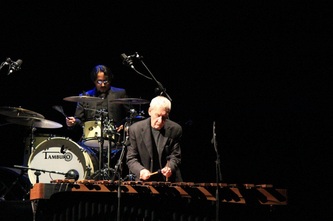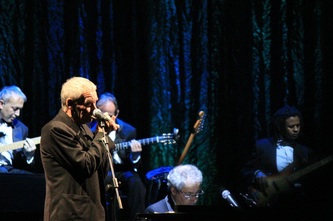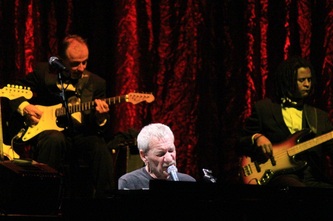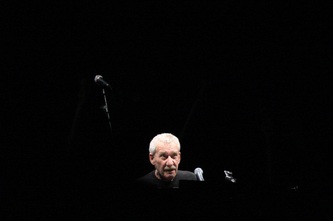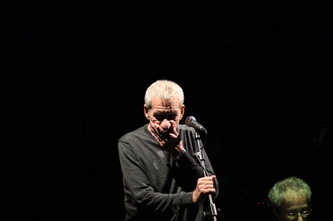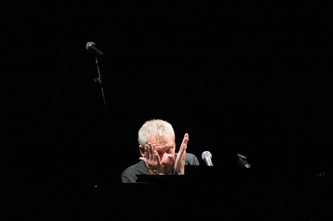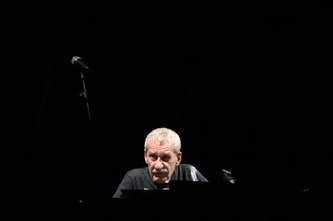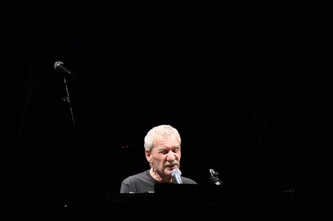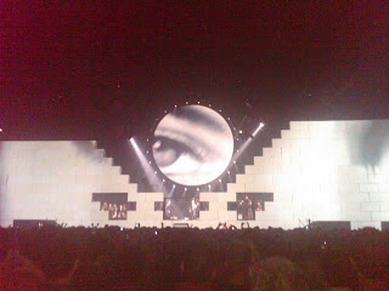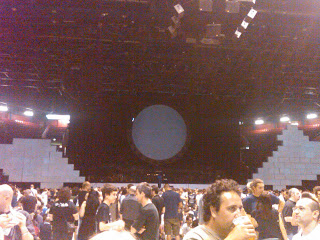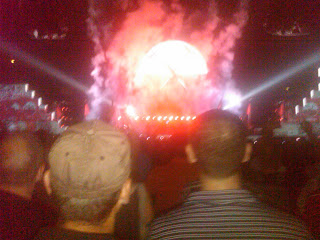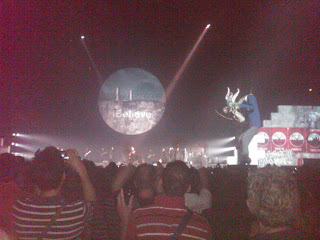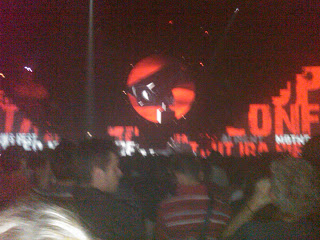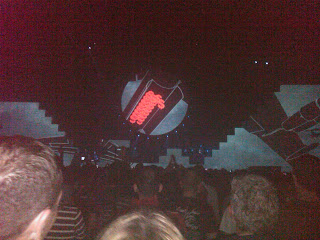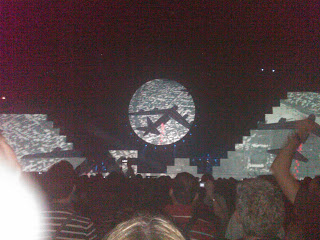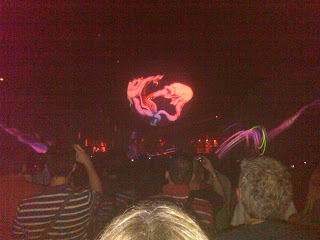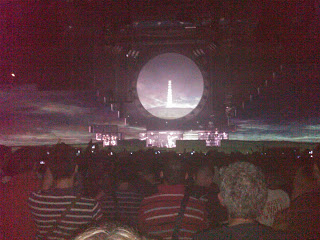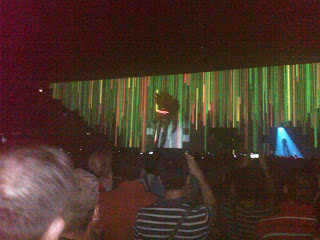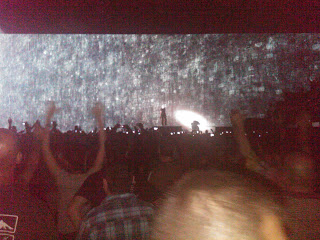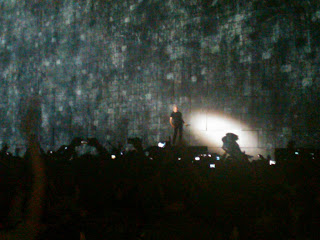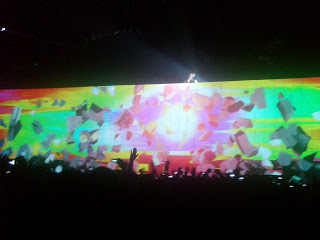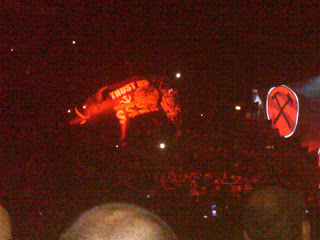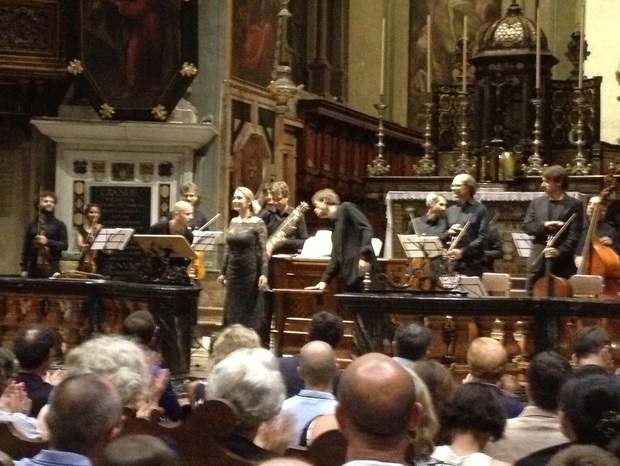|
|
|
Concerts and music events
Yale's Baroque Music in Milan
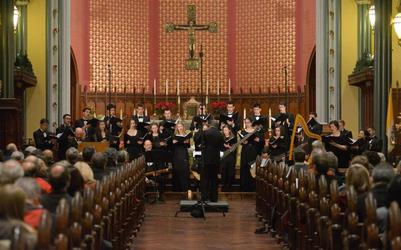
Audience like to attend big-name concerts and this is not a surprise. The other day I was walking in the city centre of Milan and I noticed a long queue outside the Mondadori Mediastore in Corso Vittorio Emanuele. I slowed my pace and curiously asked the reason for that crowd. I found out that there was a young singer, Giada, the new star of a popular tv show in Italy, “Amici di Maria de Filippi”. I have no doubts about the talent of this young girl that I do not know but I thought it was kind of strange when I saw that only a few people queued up to attend another concert in Santa Maria della Passione, a Church in Milan, on the 4th of June 2014.
The repertoire of the concert included musics by Palestrina and Vivaldi performed by the Yale Schola Cantorum, by the Yale Voxtet and by the Yale Baroque Ensemble directed by Simon Carrington.
The space under the dome was the only area engaged with people while the nave, generally occupied until at least half way, was empty. Few people, too few for the show that was about to begin and that I had the great privilege to attend.
I’d like to give you few clarifications.
The repertoire.
Palestrina, the Missa Ave Maria. It’s a composition that has close rhythms, alternate rhythms (especially in the last part of the Agnus Dei); a composition that gives a clear idea of the Rome of that time. I wonder what Palestrina could have done if only he had dwelled in Venice at the time of the Gabrieli, what a triumph of sounds would have come out of his talented mind …
And then Vivaldi, a composition that is not so famous, the Dixit Dominus RV 807 that was attributed to the composer only in recent times. There are few passages that clearly belong to Vivaldi’s style, especially in the first part of the Dixit Dominus choir that is a clear recall to the Gloria RV 589. The choral parts are alternated with parts for duo or solo singer, with the beautiful aria of the contralto in the “ De torrente in via bibet”. The encore with a Bruckner composition has demonstrated what a choir of only 20 people can achieve; our ears were buzzing; the choir has also demonstrated that baroque can be sang both in a whisper or with an amazing power.
The repertoire of the concert included musics by Palestrina and Vivaldi performed by the Yale Schola Cantorum, by the Yale Voxtet and by the Yale Baroque Ensemble directed by Simon Carrington.
The space under the dome was the only area engaged with people while the nave, generally occupied until at least half way, was empty. Few people, too few for the show that was about to begin and that I had the great privilege to attend.
I’d like to give you few clarifications.
The repertoire.
Palestrina, the Missa Ave Maria. It’s a composition that has close rhythms, alternate rhythms (especially in the last part of the Agnus Dei); a composition that gives a clear idea of the Rome of that time. I wonder what Palestrina could have done if only he had dwelled in Venice at the time of the Gabrieli, what a triumph of sounds would have come out of his talented mind …
And then Vivaldi, a composition that is not so famous, the Dixit Dominus RV 807 that was attributed to the composer only in recent times. There are few passages that clearly belong to Vivaldi’s style, especially in the first part of the Dixit Dominus choir that is a clear recall to the Gloria RV 589. The choral parts are alternated with parts for duo or solo singer, with the beautiful aria of the contralto in the “ De torrente in via bibet”. The encore with a Bruckner composition has demonstrated what a choir of only 20 people can achieve; our ears were buzzing; the choir has also demonstrated that baroque can be sang both in a whisper or with an amazing power.
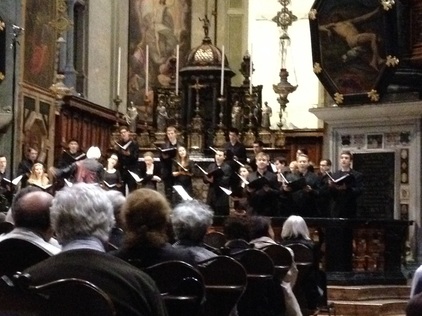
The performers.
Technically on the verge of perfection. Unknown to many (but not to Masaaki Suzuki or to Nicholas McGegan that work with them on a regular basis) and a recent establishment, they demonstrate a hard work on themselves, a great care of the single voices and of the ensemble.
While performing Palestrina they showed what “singing in a choir” means. There were not voices that dominated over other voices and all the textures were perfectly clear. Perfect incipits and closings. Clear and clean dynamics. A special reference to the soprano Sarah Yanovitch that has a beautiful and powerful voice, clean and swift; the contralto Sarah Couden with a wonderful voice, powerful and warm, and also very sensual. (The women contralto with a voice as beautiful as that of Miss Couden makes you forget about the countertenor. And if we want to be fussy we must say that Vivaldi wrote for the “Pute” that in dialect means women so a woman contralto is perfect to perform Vivaldi!).
The aria of the Dixit Dominus by Vivaldi, “De torrente in via bibet”, has literally struck the audience for the performance, the technique and the powerful voice of Miss Couden that in my opinion was the star of the night.
The performance.
Vivaldi, all in all was simpler. The music accompaniment was very helpful. The only fault I have found was in the duet of the two tenors Kyle Stegall and Gene Stenger. Sometimes their voices were too much in their throats and this ruined a bit an otherwise excellent performance. But then, in the “Dominus a dextris tuis” the soprano Kyle Stegall sang very well. Anyway, the overall result was really great. As for Palestrina the result was good exception made for a few dynamics that were too thriving for the Italian style. The beautiful voices and the team work, the clean lines and their being intelligible have created moments of sheer emotion.
Too bad that there were only few people attending. I am afraid that this choir will not come back since it’s not rewarding working and rehearsing like crazy to have such a small audience. It’s really irritating. But this would be a real shame because this choir, together with another juvenile group the British Stile Antico, have represented a real surprise. I hope they will come back and if they do I’ll be in the first row of seats.
Domenico Pizzamiglio
Translation: Francesca Rubino
Technically on the verge of perfection. Unknown to many (but not to Masaaki Suzuki or to Nicholas McGegan that work with them on a regular basis) and a recent establishment, they demonstrate a hard work on themselves, a great care of the single voices and of the ensemble.
While performing Palestrina they showed what “singing in a choir” means. There were not voices that dominated over other voices and all the textures were perfectly clear. Perfect incipits and closings. Clear and clean dynamics. A special reference to the soprano Sarah Yanovitch that has a beautiful and powerful voice, clean and swift; the contralto Sarah Couden with a wonderful voice, powerful and warm, and also very sensual. (The women contralto with a voice as beautiful as that of Miss Couden makes you forget about the countertenor. And if we want to be fussy we must say that Vivaldi wrote for the “Pute” that in dialect means women so a woman contralto is perfect to perform Vivaldi!).
The aria of the Dixit Dominus by Vivaldi, “De torrente in via bibet”, has literally struck the audience for the performance, the technique and the powerful voice of Miss Couden that in my opinion was the star of the night.
The performance.
Vivaldi, all in all was simpler. The music accompaniment was very helpful. The only fault I have found was in the duet of the two tenors Kyle Stegall and Gene Stenger. Sometimes their voices were too much in their throats and this ruined a bit an otherwise excellent performance. But then, in the “Dominus a dextris tuis” the soprano Kyle Stegall sang very well. Anyway, the overall result was really great. As for Palestrina the result was good exception made for a few dynamics that were too thriving for the Italian style. The beautiful voices and the team work, the clean lines and their being intelligible have created moments of sheer emotion.
Too bad that there were only few people attending. I am afraid that this choir will not come back since it’s not rewarding working and rehearsing like crazy to have such a small audience. It’s really irritating. But this would be a real shame because this choir, together with another juvenile group the British Stile Antico, have represented a real surprise. I hope they will come back and if they do I’ll be in the first row of seats.
Domenico Pizzamiglio
Translation: Francesca Rubino
Emma Kirkby, Harmonices Mundi and Milano
Milano ArteMusica, August 8th 2013 Concert
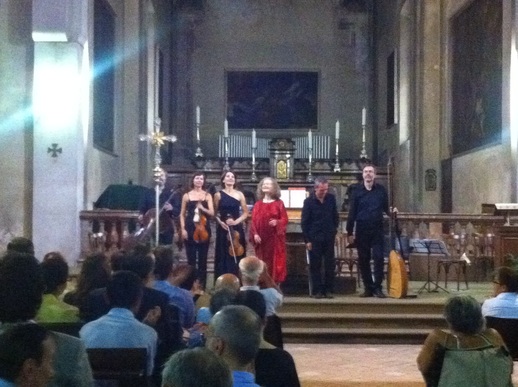
Yesterday, in the
Church of San Pietro in Gessate (Milano), took place another interesting concert that
belonged to the beautiful festival “Milano ArteMusica”. The Ensemble
Harmonices Mundi, directed by the maestro Claudio Astronio, and the Divine Emma
Kirkby, performed this time.
Emma Kirkby is
the English soprano that rediscovered the early music repertoire and that is
among the most loved for this kind of music.
Yesterday’s program title was “… in viaggio. Biagio Marini e i suoi contemporanei tra Venezia e Baviera” …
A very interesting program indeed that goes from Marini to Monteverdi with a mention to Tarquinio Merula, Barbara Strozzi, Dietrich Buxtehude, Johann Hyeronymus Kapsberger, Rupert Ignaz Mayr and Domenico Gabrielli.
The first song in program was the Sonata Seconda in 3 by Biagio Marini, in this piece, the group from Bolzano showed cohesion, precision, harmony, cantability.
Emma Kirkby then sang the Laudate Dominum by Claudio Monteverdi. In the audience’s uttermost silence her voice rose, the voice that we all know very well so precise and bright.
She met all expectations: intonation, brightness, grace notes, every word with the right stress, so to give the right meaning to the text she sang. It was exactly what we knew we would have listened to. It’s been very touching to listen to that song that we’ve heard so many times on records, but that sounds so different in a live performance. Impressive the harmony found with the group. Few songs by Marini came next, they were both instrumental and vocal.
Maestro Astronio played the positive pipe organ in Sonata Cromatica by Tarquinio Merula, a beautiful piéce that introduced the song that has most struck the audience “Canzonetta Spirituale sopra la nanna”.
The introduction predicted the real aim of the song that is not a simple lullaby. In fact, the interpretation of Mrs. Kirkby made clear the fact that it is dedicated to Jesus Christ, to which a peaceful rest is whished before the accomplishment of his doom. Emma Kirkby sang this song giving it the right meaning and feeling of anguish for the destiny of this child.
This is a very interesting song, almost contemporary for audacity and was performed wonderfully by the whole group. A Chaconne concluded the program dedicated to this author, the style of this Chaconne was very close to the style of Monteverdi.
Impressive the Ricercare Sesto by Domenico Gabrielli, performed skillfully by the cellist Maestro Alessandro Palmieri that showed his great technique.
Yesterday’s program title was “… in viaggio. Biagio Marini e i suoi contemporanei tra Venezia e Baviera” …
A very interesting program indeed that goes from Marini to Monteverdi with a mention to Tarquinio Merula, Barbara Strozzi, Dietrich Buxtehude, Johann Hyeronymus Kapsberger, Rupert Ignaz Mayr and Domenico Gabrielli.
The first song in program was the Sonata Seconda in 3 by Biagio Marini, in this piece, the group from Bolzano showed cohesion, precision, harmony, cantability.
Emma Kirkby then sang the Laudate Dominum by Claudio Monteverdi. In the audience’s uttermost silence her voice rose, the voice that we all know very well so precise and bright.
She met all expectations: intonation, brightness, grace notes, every word with the right stress, so to give the right meaning to the text she sang. It was exactly what we knew we would have listened to. It’s been very touching to listen to that song that we’ve heard so many times on records, but that sounds so different in a live performance. Impressive the harmony found with the group. Few songs by Marini came next, they were both instrumental and vocal.
Maestro Astronio played the positive pipe organ in Sonata Cromatica by Tarquinio Merula, a beautiful piéce that introduced the song that has most struck the audience “Canzonetta Spirituale sopra la nanna”.
The introduction predicted the real aim of the song that is not a simple lullaby. In fact, the interpretation of Mrs. Kirkby made clear the fact that it is dedicated to Jesus Christ, to which a peaceful rest is whished before the accomplishment of his doom. Emma Kirkby sang this song giving it the right meaning and feeling of anguish for the destiny of this child.
This is a very interesting song, almost contemporary for audacity and was performed wonderfully by the whole group. A Chaconne concluded the program dedicated to this author, the style of this Chaconne was very close to the style of Monteverdi.
Impressive the Ricercare Sesto by Domenico Gabrielli, performed skillfully by the cellist Maestro Alessandro Palmieri that showed his great technique.
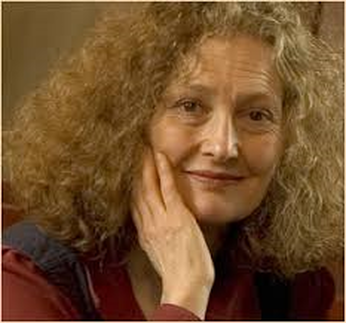
The Toccata Arpeggiata by Kapsbergher - played
with mastery by the lutanist Pietro Prosser - was beautiful and kept all the
audience in a breathless awe while they played.
Emma Kirkby sang the Salve Regina by Mayr without efforts; in the violins’ accompaniment there was an echo of Buxtehude, in fact in the Germany of the early XVII century styles mixed - just like in Venice - and the composing turmoil produced masterpieces that were similar.
In the O dulcis Jesu by Buxtehude, Emma Kirkby showed her skills and pushed with her voice showing her mastery and control in addition to her voice’s agility.
At the end of the concert the public bestowed Emma and the group with a standing ovation.
Emma welcomed all her followers, signed autographs and stopped for a few words just like she did with me.
Every time I see Emma my admiration renews, she’s a great artist, simple and polite. She’s the one that reinvented vocal interpretation of early music, nothing to share with other “so called” contemporary artists.
Yes, I truly admire this artist that has devoted her entire life to music, to the public, to the authors.
A special thanks to the organizers of this festival that is becoming more and more international for the repertoire chosen and for the artists present. The group Harmonices Mundi pleasantly surprised the audience and confirmed once again that in Italy we are not second to anybody.
My sincere compliments to the event organizers.
Domenico Pizzamiglio
Translation: Francesca Rubino
Emma Kirkby sang the Salve Regina by Mayr without efforts; in the violins’ accompaniment there was an echo of Buxtehude, in fact in the Germany of the early XVII century styles mixed - just like in Venice - and the composing turmoil produced masterpieces that were similar.
In the O dulcis Jesu by Buxtehude, Emma Kirkby showed her skills and pushed with her voice showing her mastery and control in addition to her voice’s agility.
At the end of the concert the public bestowed Emma and the group with a standing ovation.
Emma welcomed all her followers, signed autographs and stopped for a few words just like she did with me.
Every time I see Emma my admiration renews, she’s a great artist, simple and polite. She’s the one that reinvented vocal interpretation of early music, nothing to share with other “so called” contemporary artists.
Yes, I truly admire this artist that has devoted her entire life to music, to the public, to the authors.
A special thanks to the organizers of this festival that is becoming more and more international for the repertoire chosen and for the artists present. The group Harmonices Mundi pleasantly surprised the audience and confirmed once again that in Italy we are not second to anybody.
My sincere compliments to the event organizers.
Domenico Pizzamiglio
Translation: Francesca Rubino
The Tallis Scholars, Milan, Gesualdo and the 40 years of Activity
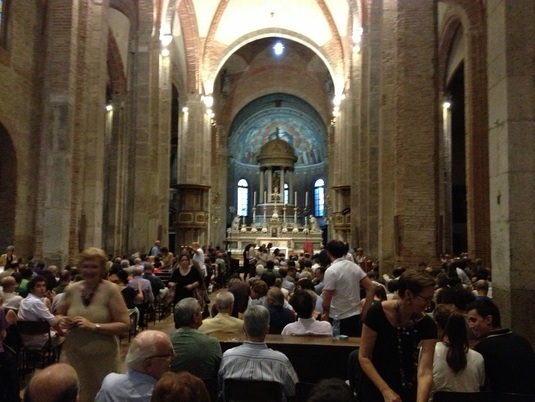
On august 1st, in the church of San Simpliciano in Milan, a beautiful romanic church of the XIII century, Tallis Scholars gave a concert. The Tallis are directed by Maestro Peter Phillips, and this year they celebrate their 40th anniversary of activity. Forty years packed with important and prestigious events but in my opinion the main achievement of this group is the visibility they have given to a repertoire of the Renaissance that was barely known before them.
The expectancy was very high and the Tallis have not disappointed the audience, of course. This group has the ability to amaze every time they perform and this is what keeps alive the interest for ancient music, an interest that in the hot and lazy Milan of these summer dog days is even more astonishing
The expectancy was very high and the Tallis have not disappointed the audience, of course. This group has the ability to amaze every time they perform and this is what keeps alive the interest for ancient music, an interest that in the hot and lazy Milan of these summer dog days is even more astonishing
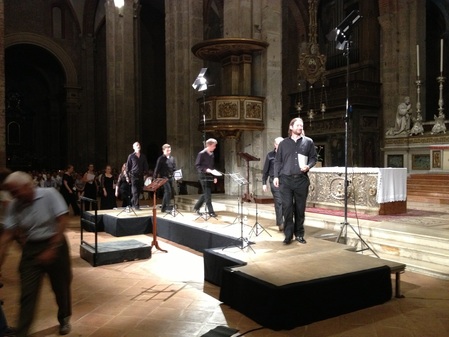
The program of the performance was really ambitious. The first part was dedicated to Carlo Gesualdo Prince of Venosa: the Tenebrae Responsories for Holy Saturday. I must confess that the stylistic choice puzzled me a little bit, the singing was always in "forte" and the tenors had a special emphasis in their voices. Still, their simplicity and perfection of intonation were amazing and I felt envious and awe-struck. In the second part of the concert they sang two beautiful pieces by Arvo Part. The Tallis here have been simply perfect with very accurate changes from pianissimo to fortissimo, with the dissonances by Part very well performed. Very impressive the intonation and the length of the long notes, kept up without "vibrato" of the voice, a clear sign of the mastery they have in their art. The program went on with authors that are less famous, and finished with a tribute to Italy a mottetto by Claudio Monteverdi
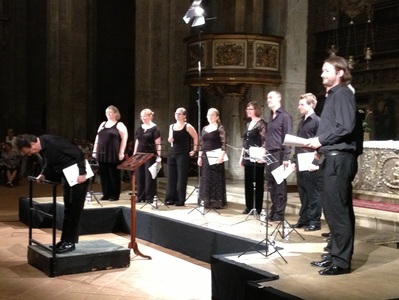
At the end of the performance, the public was amazed and delighted and forgetful of the heat thanks to the beauty and perfection of their performance.
Two years ago the Tallis Scholars performed in Milan, in the Church of Santa Maria della Passione and their performance had its climax in the Miserere by Allegri; their encore in Milan this year was really worth being present.
I want to add that the acoustic of the church of San Simpliciano is really perfect: the voices are all clear even at the bottom of the central aisle, and nothing gets lost. The audience then, has been really respectful and quiet, despite the hot weather. Milan is a sensible, mature city also for the least popular repertoires and as a citizen of Milano I am proud of it.
The next appointment will be with the concert of the Dame Carolyn Emma Kirkby, in the church of San Pietro in Gessate, in Milan, during the beautiful festival Milano ArteMusica.
Domenico Pizzamiglio
Translation: Francesca Rubino
Two years ago the Tallis Scholars performed in Milan, in the Church of Santa Maria della Passione and their performance had its climax in the Miserere by Allegri; their encore in Milan this year was really worth being present.
I want to add that the acoustic of the church of San Simpliciano is really perfect: the voices are all clear even at the bottom of the central aisle, and nothing gets lost. The audience then, has been really respectful and quiet, despite the hot weather. Milan is a sensible, mature city also for the least popular repertoires and as a citizen of Milano I am proud of it.
The next appointment will be with the concert of the Dame Carolyn Emma Kirkby, in the church of San Pietro in Gessate, in Milan, during the beautiful festival Milano ArteMusica.
Domenico Pizzamiglio
Translation: Francesca Rubino
When an Old Glory Gets Back on Stage
Lorin Maazel and the Munich Philharmonic Orchestra
Yesterday, Sunday May 12th 2013 at 11 a.m., at the Munich Gasteig, Lorin Maazel directed a concert; he's an old glory, his first performance dates back many years ago when he was a young man. He's now 83 years old but he's still very young at heart and a couple of jumps he made on stage while directing made me seriously doubt about his real age. Also when you look at him, as I did when I met him in the backstage, you have the impression to be in front of a man in his 60s.
Muenchner Philhamoniker Orchestra is a premium quality orchestra, it has a great unity in its performances, also in the most difficult passages, it is able to manage the lowest sounds but also the highest fortissimo with the same mastery, it is a real Music Machine.
Maestro Maazel needs no introductions, he's able to direct the orchestra and he does it with the highest care for the smallest details. It's a winning combination that performed in one of the best sounding European music halls: the Gasteig. I hope that the picture taken during the final ovation may describe the general enthusiasm.
The program of the concert included pieces by Prokofiev and Brahms, featuring the young and charming Janine Jansen at the violin.
The concert begun with "Romeo and Juliet" and maybe the most famous piece of this ballet "Capuleti and Montecchi". Just few passages and we all understood that Maazel had transformed this piece in a concert music with rhythm sostenuto, very large dynamics, and orchestral color helped by the hall acoustic and by the Orchestra in its best shape. "Dance with Mandolins" has followed the first pièce and then "Teobaldo's Death", both with the same sustained rhythm that is Maazel's feature trait since always.
The second pièce in program was the Concert for violin and Orchestra by Prokofiev. Janine Jansen, violin player, gave us a show of her skill. This pièce is not easy, neither for the soloist, nor for the orchestra, but the two played wonderfully together. No mistakes, no imperfections, just the joy and enjoyment of playing together. Mrs. Jansen gave proof not only of her skills but also of a unique touch that goes through the many different hues of the music score. An odd concert because the constant interplay violin/orchestra left no space to that typical 19th century virtuosity. The orchestra had to stay behind the violin and not dominate it but for Maazel this was an easy task. Mrs. Jansen then rewarded us with an encore, a dance from a partita for violin by Bach. Technical perfection went side by side to a typical feminine sensibility that added some "rubato" wich made this composition very up to date and far from that baroque execution to which we are used.
At the end of the concert, they played the second symphony by Johannes Brahms in which Lorin Maazel evidenced the most sweet and cantabile moments from those that are more harsh and powerful. The final was so well directed and so timely in its incipits and in the rhythm that the whole parterre exploded in an ovation.
It's all for now, see you soon for another reportage of some other concert from Munich.
Domenico Pizzamiglio
Translation: Francesca Rubino
Muenchner Philhamoniker Orchestra is a premium quality orchestra, it has a great unity in its performances, also in the most difficult passages, it is able to manage the lowest sounds but also the highest fortissimo with the same mastery, it is a real Music Machine.
Maestro Maazel needs no introductions, he's able to direct the orchestra and he does it with the highest care for the smallest details. It's a winning combination that performed in one of the best sounding European music halls: the Gasteig. I hope that the picture taken during the final ovation may describe the general enthusiasm.
The program of the concert included pieces by Prokofiev and Brahms, featuring the young and charming Janine Jansen at the violin.
The concert begun with "Romeo and Juliet" and maybe the most famous piece of this ballet "Capuleti and Montecchi". Just few passages and we all understood that Maazel had transformed this piece in a concert music with rhythm sostenuto, very large dynamics, and orchestral color helped by the hall acoustic and by the Orchestra in its best shape. "Dance with Mandolins" has followed the first pièce and then "Teobaldo's Death", both with the same sustained rhythm that is Maazel's feature trait since always.
The second pièce in program was the Concert for violin and Orchestra by Prokofiev. Janine Jansen, violin player, gave us a show of her skill. This pièce is not easy, neither for the soloist, nor for the orchestra, but the two played wonderfully together. No mistakes, no imperfections, just the joy and enjoyment of playing together. Mrs. Jansen gave proof not only of her skills but also of a unique touch that goes through the many different hues of the music score. An odd concert because the constant interplay violin/orchestra left no space to that typical 19th century virtuosity. The orchestra had to stay behind the violin and not dominate it but for Maazel this was an easy task. Mrs. Jansen then rewarded us with an encore, a dance from a partita for violin by Bach. Technical perfection went side by side to a typical feminine sensibility that added some "rubato" wich made this composition very up to date and far from that baroque execution to which we are used.
At the end of the concert, they played the second symphony by Johannes Brahms in which Lorin Maazel evidenced the most sweet and cantabile moments from those that are more harsh and powerful. The final was so well directed and so timely in its incipits and in the rhythm that the whole parterre exploded in an ovation.
It's all for now, see you soon for another reportage of some other concert from Munich.
Domenico Pizzamiglio
Translation: Francesca Rubino
January 25th Concert at Theatre Carlo Felice
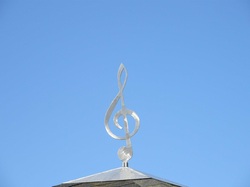
Director Andrea Battistoni
Piano Roberto Cominati
Edvard Grieg: Piano concert in A minor - op 16
Grieg composed this concert when he was 25 y.o. He dedicated it to the great German composer R Schumann. Grieg expresses in this opera his strong personality filled with juvenile strength.
The characteristic of this concert is the sense of musical transformation that is supposed to represent the differences of state between water and ice, light and night, black and white of the Nordic landscape.
The suite of the piano player is as black as the night at first...but then...we see a white suite, like a prince's suite with studs and sequins following the purest tradition of the silent German Romanticism. His hands, held up vertically, are like angel's wings that barely touch the cold water and with a rhythmic sound transform water into ice crystals that are aligned on the keyboard. He does all this playing with deep penetrating sounds. At the joyful rhythm of youth a rare and precious red flower appears in the icy Nordic landscape.
The performance of this young director is characterized by different sound plans. He puts the piano in evidence and it becomes the absolute interpreter of this opera. In the background there is the orchestra. The director and the piano player are dressed in the colors of Norway, a land of contrasts and great impacts. A land that Grieg loved deeply.
This concert is well known so it's not easy to say something original. The director did a great performance and the absence of a piano with a deep timbre was barely noticeable. He succeeded in doing this by putting an invisible filter, a sort of sound curtain that recreated that force, that distance between the sound plans that are fundamental to interpret the concert in the right way. The historical and geographical collocation is Nordic and German so the piano with a deep sound is a must.
Piano Roberto Cominati
Edvard Grieg: Piano concert in A minor - op 16
Grieg composed this concert when he was 25 y.o. He dedicated it to the great German composer R Schumann. Grieg expresses in this opera his strong personality filled with juvenile strength.
The characteristic of this concert is the sense of musical transformation that is supposed to represent the differences of state between water and ice, light and night, black and white of the Nordic landscape.
The suite of the piano player is as black as the night at first...but then...we see a white suite, like a prince's suite with studs and sequins following the purest tradition of the silent German Romanticism. His hands, held up vertically, are like angel's wings that barely touch the cold water and with a rhythmic sound transform water into ice crystals that are aligned on the keyboard. He does all this playing with deep penetrating sounds. At the joyful rhythm of youth a rare and precious red flower appears in the icy Nordic landscape.
The performance of this young director is characterized by different sound plans. He puts the piano in evidence and it becomes the absolute interpreter of this opera. In the background there is the orchestra. The director and the piano player are dressed in the colors of Norway, a land of contrasts and great impacts. A land that Grieg loved deeply.
This concert is well known so it's not easy to say something original. The director did a great performance and the absence of a piano with a deep timbre was barely noticeable. He succeeded in doing this by putting an invisible filter, a sort of sound curtain that recreated that force, that distance between the sound plans that are fundamental to interpret the concert in the right way. The historical and geographical collocation is Nordic and German so the piano with a deep sound is a must.
Modest Mussorgski j- Maurice Ravel - Pictures at an Exhibition
Promenade - Gnomo - Promenade - The Old Castle - Promenade - Tuileries - Bydło - Promenade - Ballet of the Unhatched Chicks - Samuel Goldenberg e Schmuÿle - Limoges, the Market - Catacombae (Sepulcrum Romanum) / Cum mortuis in lingua mortua - The Hut on Fowl's Hat (Baba-Yaga) - The Great Gate of Kiev
Mussorgkij was born in 1839 and died in 1881. The two authors are more or less contemporaries and belong to two cultures that are close but different: the Russian and the Norwegian. They are both rooted in their traditions even if Mussorgskij is somehow different from his contemporaries such as Chaikovskij for example.
The director presents Mussorgskij's opera in a version that is more authentic and visible than ever. He introduces the first piece very softly and from the second movement on there is a very moderate background made of obsessive timbres that are a prediction of the period to come: 1900 - the period of obsession Mussorgskij was a real anticipator of the times because he wrote this opera - that is very modern - in 1874, at the beginning of Belle Epoque. The director made the execution slower somehow focusing our attention on the silence, making us stare at ear's height and making us feel like walking while observing, step after step, exactly there where the sound is creating all the pictures that are all hanged on the same line. We suddenly forget what is around us. We are attracted by the variety and multiplicity of timbres that become music in movement. Only the artist's hand knows where to place the colors to maximize the effects. The director makes all the images appear and we see pictures materialize with their beautiful shapes and colors. The color/sound creates the picture key after key, timbre after timbre. Pictures appear to us so close and real that for a second we are no more in the theatre, these gestures of love take us to a special place.
A special thanks to the director that made this vision possible and real and synesthesic in both pieces.
The piano player was great. The first violin, Elisabetta Garetti, was very aristocratic, mettlesome and energetic with a splendid body language. She is a strong and very North European figure.
Marina Pacini e Carmine Contese
Translation: Francesca Rubino
Promenade - Gnomo - Promenade - The Old Castle - Promenade - Tuileries - Bydło - Promenade - Ballet of the Unhatched Chicks - Samuel Goldenberg e Schmuÿle - Limoges, the Market - Catacombae (Sepulcrum Romanum) / Cum mortuis in lingua mortua - The Hut on Fowl's Hat (Baba-Yaga) - The Great Gate of Kiev
Mussorgkij was born in 1839 and died in 1881. The two authors are more or less contemporaries and belong to two cultures that are close but different: the Russian and the Norwegian. They are both rooted in their traditions even if Mussorgskij is somehow different from his contemporaries such as Chaikovskij for example.
The director presents Mussorgskij's opera in a version that is more authentic and visible than ever. He introduces the first piece very softly and from the second movement on there is a very moderate background made of obsessive timbres that are a prediction of the period to come: 1900 - the period of obsession Mussorgskij was a real anticipator of the times because he wrote this opera - that is very modern - in 1874, at the beginning of Belle Epoque. The director made the execution slower somehow focusing our attention on the silence, making us stare at ear's height and making us feel like walking while observing, step after step, exactly there where the sound is creating all the pictures that are all hanged on the same line. We suddenly forget what is around us. We are attracted by the variety and multiplicity of timbres that become music in movement. Only the artist's hand knows where to place the colors to maximize the effects. The director makes all the images appear and we see pictures materialize with their beautiful shapes and colors. The color/sound creates the picture key after key, timbre after timbre. Pictures appear to us so close and real that for a second we are no more in the theatre, these gestures of love take us to a special place.
A special thanks to the director that made this vision possible and real and synesthesic in both pieces.
The piano player was great. The first violin, Elisabetta Garetti, was very aristocratic, mettlesome and energetic with a splendid body language. She is a strong and very North European figure.
Marina Pacini e Carmine Contese
Translation: Francesca Rubino
New Year's concert 2013 at the Theatre Carlo Felice
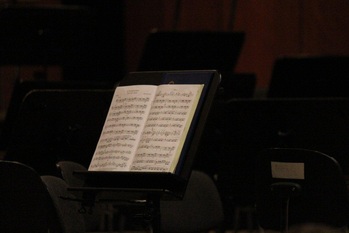
Director Donato Renzetti
Piano Massimiliano Damerini
Petr ll'c Čajkovskij Piano Concert n.1 in b flat minor
George Gershwin An American in Paris
John Williams Star Wars Suite
It's the first of January 2013 and we are going to the theatre Carlo Felice in Genova, but why? The friendly Orchestra of the Theatre Carlo Felice takes us into the atmosphere over the XIXth and XXth century and has the ability of mixing the sounds of two epochs that are close but different and the result is something that vibrates and transforms itself into a blended body. At the Carlo Felice there is not a serious orchestra but an orchestra that is close to the audience, that thinks like the audience. In this way the audience is activated by the orchestra and is taken into the Opera and forms a unique body with it. The two operas are very peculiar and you either like it or dislike it. The question now is: why these two operas together? Which is the link between the two? There is one thing that is apparent, the Russian origin of the composers. Čajkovskij and Gershwin. How can we define the music of these two composers? Čajkovskij is the uncertain while Gershwin is the unintelligible. This is what we perceive in their music. Why these two concerts together then? The answer is beauty. In the first opera is present the need of the man to pursue beauty. It's a natural journey but it's not a journey free from soul tearing conflicts that proceeds slowly. Čajkovskij shows us that the fate is unpredictable and when you least expect it, in the most unthinkable place astonishment and wonder will appear to you. Your breath stops, you feel a pain that you recognize as you do with your face in the mirror and suddenly you see what you are. The visual impression of Čajkovskij's music is similar to what strikes you when you see something bizarre and fantastic and you're not ready for it. You feel a strong hand that clasps you and you have to stop. In the same way under the majesty of the strings the dissonant piano hits you. Thanks to this music impact you realize that the strength of beauty exists and that you exist. Čajkovskij had doubts about his identity but he was able to find beauty straight away in his music. As for Gershwin his quest for beauty is not slow but it's fast, faster due to modern times but he still finds it difficult to see beauty even when he's surrounded by it. The quest proceeds in the middle of cacophonies and glares, in the fragmentations of the society and of its mechanisms, between the soul anxieties that are felt among mismatches and elusive notes but suddenly, a dawn of green fluorescent dye comes out as a sensual recall of elegance and refinement and between horns, car lights and light flashes on the shop windows and in the puddles on the sidewalk beauty suddenly pops out without a reason. The quest for beauty wears us out and takes us to dejection, we have to find the strength to fight the evil that tries to destroy it. The heroes of the Carlo Felice performing Star Wars Theme with the director wielding a laser sword give us the energy to proceed and to believe in these men that we will never stop discovering.
"May the Force be with you" and Happy New Year.
Marina Pacini e Carmine Contese
Translation: Francesca Rubino
Piano Massimiliano Damerini
Petr ll'c Čajkovskij Piano Concert n.1 in b flat minor
George Gershwin An American in Paris
John Williams Star Wars Suite
It's the first of January 2013 and we are going to the theatre Carlo Felice in Genova, but why? The friendly Orchestra of the Theatre Carlo Felice takes us into the atmosphere over the XIXth and XXth century and has the ability of mixing the sounds of two epochs that are close but different and the result is something that vibrates and transforms itself into a blended body. At the Carlo Felice there is not a serious orchestra but an orchestra that is close to the audience, that thinks like the audience. In this way the audience is activated by the orchestra and is taken into the Opera and forms a unique body with it. The two operas are very peculiar and you either like it or dislike it. The question now is: why these two operas together? Which is the link between the two? There is one thing that is apparent, the Russian origin of the composers. Čajkovskij and Gershwin. How can we define the music of these two composers? Čajkovskij is the uncertain while Gershwin is the unintelligible. This is what we perceive in their music. Why these two concerts together then? The answer is beauty. In the first opera is present the need of the man to pursue beauty. It's a natural journey but it's not a journey free from soul tearing conflicts that proceeds slowly. Čajkovskij shows us that the fate is unpredictable and when you least expect it, in the most unthinkable place astonishment and wonder will appear to you. Your breath stops, you feel a pain that you recognize as you do with your face in the mirror and suddenly you see what you are. The visual impression of Čajkovskij's music is similar to what strikes you when you see something bizarre and fantastic and you're not ready for it. You feel a strong hand that clasps you and you have to stop. In the same way under the majesty of the strings the dissonant piano hits you. Thanks to this music impact you realize that the strength of beauty exists and that you exist. Čajkovskij had doubts about his identity but he was able to find beauty straight away in his music. As for Gershwin his quest for beauty is not slow but it's fast, faster due to modern times but he still finds it difficult to see beauty even when he's surrounded by it. The quest proceeds in the middle of cacophonies and glares, in the fragmentations of the society and of its mechanisms, between the soul anxieties that are felt among mismatches and elusive notes but suddenly, a dawn of green fluorescent dye comes out as a sensual recall of elegance and refinement and between horns, car lights and light flashes on the shop windows and in the puddles on the sidewalk beauty suddenly pops out without a reason. The quest for beauty wears us out and takes us to dejection, we have to find the strength to fight the evil that tries to destroy it. The heroes of the Carlo Felice performing Star Wars Theme with the director wielding a laser sword give us the energy to proceed and to believe in these men that we will never stop discovering.
"May the Force be with you" and Happy New Year.
Marina Pacini e Carmine Contese
Translation: Francesca Rubino
Paolo Conte, tour 2012
Paolo Conte: enchanter or illusionist?
The curtains open up. All the instruments on stage magically come to life: in the sound mechanism the contact between man and instrument gets lost as if the latter was gifted with a life of its own. All this recalls to our mind the self moving tin toys of the early XXth Century.
The magic alchemy between Paolo Conte "the clocksmith" and the "facetious characters" of the orchestra creates refined sonorities and the sound sequences - in the room - seem to come alive by their own just like in the Nutcracker by Hoffmann. Joy is immense and permeates the entire concert. The deep synergy between the playmaster and his acolyte wraps up the entire theatre: stage and parterre.
What kind of magic unites the man and its instrument? Who plays who?
The melodies become one and all the impossible becomes possible, becomes reality. Smoky milongas, nights in a suburban pub of the 50's, offbeat boxeur, second hand exotism and barking dogs ... you get lost in time listening
to the classic repertoire of this lawyer from Alessandria, variations on the theme that are always recognizable and typical of his personal and at the same time universal style that sounds as familiar as the voice of a relative.
The violin, is in my personal opinion masterly, unusual and heavenly like the exotic percussions and the local percussions, the woodwinds and the brasses.
Marina Pacini and Carmine Contese
Translation: Francesca Rubino
Paolo Conte
Nunzio Barbieri (Chitarra – Chitarra Elettrica), Lucio Caliendo (Obo e – Fagotto – Percussioni – Tastiere), Claudio Chiara (Alto Sax – Sax Tenore – Sax Baritono – Flauto Dolce – Accordéon – Basso – Tastiere), Daniele Dall’Omo (Chitarre), Daniele Di Gregorio (Batteria – Percussioni – Marimba – Piano), Luca Enipeo (Chitarra), Massimo Pitzianti (Accordéon – Bandoneón – Clarinetto – Sax Baritono – Piano – Tastiere), Piergiorgio Rosso
(Violino), Jino Touche (Contrabbasso – Chitarra Elettrica), Luca Velotti (Sax Soprano – Sax Tenore – Sax Contralto – Sax Baritono - Clarinetto).
The curtains open up. All the instruments on stage magically come to life: in the sound mechanism the contact between man and instrument gets lost as if the latter was gifted with a life of its own. All this recalls to our mind the self moving tin toys of the early XXth Century.
The magic alchemy between Paolo Conte "the clocksmith" and the "facetious characters" of the orchestra creates refined sonorities and the sound sequences - in the room - seem to come alive by their own just like in the Nutcracker by Hoffmann. Joy is immense and permeates the entire concert. The deep synergy between the playmaster and his acolyte wraps up the entire theatre: stage and parterre.
What kind of magic unites the man and its instrument? Who plays who?
The melodies become one and all the impossible becomes possible, becomes reality. Smoky milongas, nights in a suburban pub of the 50's, offbeat boxeur, second hand exotism and barking dogs ... you get lost in time listening
to the classic repertoire of this lawyer from Alessandria, variations on the theme that are always recognizable and typical of his personal and at the same time universal style that sounds as familiar as the voice of a relative.
The violin, is in my personal opinion masterly, unusual and heavenly like the exotic percussions and the local percussions, the woodwinds and the brasses.
Marina Pacini and Carmine Contese
Translation: Francesca Rubino
Paolo Conte
Nunzio Barbieri (Chitarra – Chitarra Elettrica), Lucio Caliendo (Obo e – Fagotto – Percussioni – Tastiere), Claudio Chiara (Alto Sax – Sax Tenore – Sax Baritono – Flauto Dolce – Accordéon – Basso – Tastiere), Daniele Dall’Omo (Chitarre), Daniele Di Gregorio (Batteria – Percussioni – Marimba – Piano), Luca Enipeo (Chitarra), Massimo Pitzianti (Accordéon – Bandoneón – Clarinetto – Sax Baritono – Piano – Tastiere), Piergiorgio Rosso
(Violino), Jino Touche (Contrabbasso – Chitarra Elettrica), Luca Velotti (Sax Soprano – Sax Tenore – Sax Contralto – Sax Baritono - Clarinetto).
Roger Waters: a 30 years old wall
Classical things are always up to date. One of these things is, for sure, a Roger Waters' concert. In July 2011 I wrote a piece for my blog that I want to propose again here.
It was 1979 when I bought the brand new LP of the group, alas a long time ago; at that time Roger Waters wrote his songs with and for the Pink Floyd. I like better other works of the English band, The Wall is a record dominated by anguish, a dark atmosphere and rhetorical - but not trite - lyrics. It's the vent of a person hurt by the horror of the war in which he lost his father. All this happens in Anzio, Italy, by the way. Roger Water demonstrates a rare artistic vein and a vision of the musical future that has granted the survival of this masterpiece, a classic of rock music. It is useless to talk about The Wall and I'd better focus on the features of the concert we attended yesterday in a sold out - but not too crowded - stadium. The tour manager did a great job.
This is a year-long concert tour that traveled around the world. In Milan we had another stop-over in April but the requests were so numerous that two more dates have been added. Athens will be the last stop and a DVD will be recorded there to close the tour. The show is a big parade of lights, fireworks, clips from the movie, boars with eyes on fire that fly over the public, ugly inflatable teachers that scold pupils, bad and nasty women that want to seduce the poor Pink.There's also a mother-master that knows the answers to all possible questions and "will make nightmares come true", she will" frighten you in every possible way" and "won't allow you to fly but only to sing and will help to build the wall". I found on-line enthusiastic comments, people that defined this concert the best ever. As a music reviewer I will be less delighted. Musically there's nothing to say, Waters is close to perfection. He dominates with his electric bass, he shows an experience and the technique gained in many glorious years. Dave Kliminster plays guitar with the self-confidence gained recording 15 albums and fears no comparison with David Gilmour. The second guitar is an old acquaintance of ours: Snowy White. Graham Broad has a very good drumming and has played with Waters many times.
The choice of the second voice is somehow curious. The role of the mother in "Mother" is played by a man. For those that saw " In The Flesh", live or on DVD, and are used to the voice of Katie Kissoon it's almost like listening to a parody. The male choir is not satisfying for those that love concerts. My idea is that choirs must be female, or mixed. Left aside that for Gregorian Chant we have to look somewhere else.
The setting is that of The Wall. The brick wall is built to cover the band and the stage and in the middle of the concert it becomes a big silver screen. Special effects, high resolution images and a beautiful computer graphics complete the scene. For those that attended Pink Floyd's "Pulse" live with that incredible display of means this concert is very good but not stunning. I recall coming back from Torino after the "Pulse" concert with my eyes full of laser lights, haunted by the images of the stage, shocked by the huge crystal ball that popped out from nothing in the middle of the audience. All in all good things exceed bad things and after all Roger Waters in concert is a show that one can't miss, a unique occasion. Seeing him so close it's an emotion. The sensation of touching the milestones of rock, the icons of the history of music, the idol of your teen-years is an experience worth living and rewarding.
I discovered only on arrival that cameras were allowed. It was too late to remedy so you'll have to make do with the pictures taken with the smart-phone.
Angelo Jasparro
Translation: Francesca Rubino
It was 1979 when I bought the brand new LP of the group, alas a long time ago; at that time Roger Waters wrote his songs with and for the Pink Floyd. I like better other works of the English band, The Wall is a record dominated by anguish, a dark atmosphere and rhetorical - but not trite - lyrics. It's the vent of a person hurt by the horror of the war in which he lost his father. All this happens in Anzio, Italy, by the way. Roger Water demonstrates a rare artistic vein and a vision of the musical future that has granted the survival of this masterpiece, a classic of rock music. It is useless to talk about The Wall and I'd better focus on the features of the concert we attended yesterday in a sold out - but not too crowded - stadium. The tour manager did a great job.
This is a year-long concert tour that traveled around the world. In Milan we had another stop-over in April but the requests were so numerous that two more dates have been added. Athens will be the last stop and a DVD will be recorded there to close the tour. The show is a big parade of lights, fireworks, clips from the movie, boars with eyes on fire that fly over the public, ugly inflatable teachers that scold pupils, bad and nasty women that want to seduce the poor Pink.There's also a mother-master that knows the answers to all possible questions and "will make nightmares come true", she will" frighten you in every possible way" and "won't allow you to fly but only to sing and will help to build the wall". I found on-line enthusiastic comments, people that defined this concert the best ever. As a music reviewer I will be less delighted. Musically there's nothing to say, Waters is close to perfection. He dominates with his electric bass, he shows an experience and the technique gained in many glorious years. Dave Kliminster plays guitar with the self-confidence gained recording 15 albums and fears no comparison with David Gilmour. The second guitar is an old acquaintance of ours: Snowy White. Graham Broad has a very good drumming and has played with Waters many times.
The choice of the second voice is somehow curious. The role of the mother in "Mother" is played by a man. For those that saw " In The Flesh", live or on DVD, and are used to the voice of Katie Kissoon it's almost like listening to a parody. The male choir is not satisfying for those that love concerts. My idea is that choirs must be female, or mixed. Left aside that for Gregorian Chant we have to look somewhere else.
The setting is that of The Wall. The brick wall is built to cover the band and the stage and in the middle of the concert it becomes a big silver screen. Special effects, high resolution images and a beautiful computer graphics complete the scene. For those that attended Pink Floyd's "Pulse" live with that incredible display of means this concert is very good but not stunning. I recall coming back from Torino after the "Pulse" concert with my eyes full of laser lights, haunted by the images of the stage, shocked by the huge crystal ball that popped out from nothing in the middle of the audience. All in all good things exceed bad things and after all Roger Waters in concert is a show that one can't miss, a unique occasion. Seeing him so close it's an emotion. The sensation of touching the milestones of rock, the icons of the history of music, the idol of your teen-years is an experience worth living and rewarding.
I discovered only on arrival that cameras were allowed. It was too late to remedy so you'll have to make do with the pictures taken with the smart-phone.
Angelo Jasparro
Translation: Francesca Rubino
Georg Friedrich HÄNDEL: Concerti Grossi e Musica Sacra
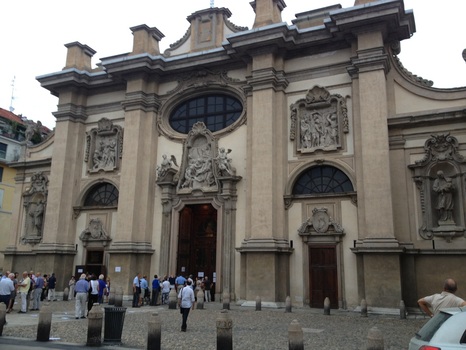
The wonderful venue of the Basilica di Santa Maria della Passione in the center of Milano hosted this concert.
There's not much to say about Haendel, German-born musician that lived in London. He lived between the XVII and XVIII century and he composed, among other pieces, the very famous Messiah. The Conductor, Maestro Ottavio Dantone, virtuoso of harpsichord and fortepiano, won many important prizes and is at the moment Director of the Accademia Bizantina of Ravenna. Carolyn Sampson is a British soprano with an outstanding résumé, she took part as soloist to The King's Consort tour. 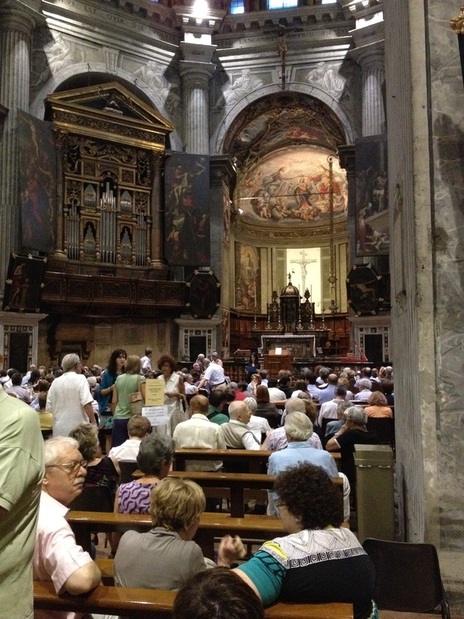
The style of the Concerto Grosso developed in Italy in the second half of 1600 and is characterized by forte and piano effects.
This characteristic has been perfectly expressed by Dantone that directed passionately the orchestra with his peculiar touch. Among the sacred music we listened to the Gloria, Salve Regina and Haec est Regina Virginum. These pieces were composed by Haendel during his Roman stay. Carolyn Sampson demonstrated the rare capacity of acting while singing communicating a rare sweetness and an emotion typical of prayers. This is remarkable since we often attend to performances of sopranos that sing with a perfect technique but don't transmit emotion. Pictures have been taken with the smartphone and have not a good resolution but I want to emphasize the splendour of the church that hosted the concert located next to the famous Conservatorio of the City of Milano. Angelo Jasparro Translation: Francesca Rubino |

